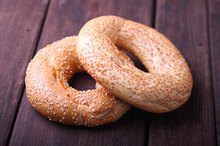What does fact checked mean?
At Healthfully, we strive to deliver objective content that is accurate and up-to-date. Our team periodically reviews articles in order to ensure content quality. The sources cited below consist of evidence from peer-reviewed journals, prominent medical organizations, academic associations, and government data.
The information contained on this site is for informational purposes only, and should not be used as a substitute for the advice of a professional health care provider. Please check with the appropriate physician regarding health questions and concerns. Although we strive to deliver accurate and up-to-date information, no guarantee to that effect is made.
The Glycemic Index of Condiments
No summer barbecue with hamburgers and hot dogs is complete without a selection of condiments. These tangy additions add flavor and color to your meal but also play a role in the increase of your blood sugar. As with foods, condiments have a glycemic index that indicates how quickly they impact your blood sugar.
Glycemic Index and Your Blood Sugar
The glycemic index of foods, including condiments, lets you know how eating certain foods impacts your blood sugar and overall health 123. A food's glycemic index ranks how quickly it raises your blood sugar. Foods with a glycemic index of 70 or above are high-glycemic foods and cause a rapid rise in your blood sugar. Those between 56 and 70 are medium. Foods 55 or below are low-glycemic foods, which means they won't cause your blood sugar to increase rapidly. Rapidly increasing blood sugar can lead to short-term issues such as mood changes and long-term illnesses such as Type 2 diabetes.
- The glycemic index of foods, including condiments, lets you know how eating certain foods impacts your blood sugar and overall health 1.
- Foods with a glycemic index of 70 or above are high-glycemic foods and cause a rapid rise in your blood sugar.
Ketchup, Mayo, Mustard and Relish
Dijon Mustard Nutrition
Learn More
Ketchup has a glycemic index of 55, giving it a low-glycemic ranking, according to the Montignac Method website 2. Homemade mayonnaise has a glycemic index of zero, but commercial, sweetened mayo has a glycemic index of 60. Dijon-style mustard's glycemic index is 35, and sugar-added mustard has an index of 55. The Montignac Method website doesn't provide a glycemic index for sweet relish, but a 2002 article in the "Crossfit Journal" reports sweet relish has a high glycemic index 2.
Other Condiments
Sauerkraut has a glycemic index of 15, while unsweetened soy sauce has an index of zero. Vinegar, which you might use to top fries, has a glycemic index of 5. Hummus, which serves as a condiment for Middle East-style dishes, has a glycemic index of 25.
Consider Your Other Foods
Mustard and Weight Loss
Learn More
Evaluating the glycemic index of the foods with which you plan to eat condiments ensures you take ownership of your diet 12. If you enjoy condiments on a hamburger, for example, be aware that a hamburger bun has a glycemic index of 61. A kaiser roll has a glycemic index of 73, while white bread has a rank of 71. Other foods that you might enjoy with your meal are also important to consider. Potato chips, for example, have a glycemic index of 51 3.
Related Articles
References
- Eat Right Ontario: Getting to Know the Glycemic Index
- The Crossfit Journal: Glycemic Index
- Harvard Health Publications: Glycemic Index and Glycemic Load for 100+ Foods
- Johns Hopkins Medicine: Get Off the Blood Glucose Roller Coaster
- American Diabetes Association. Diabetes Superfoods.
- Glycemic Index. Glycemic Search Index.
Writer Bio
Toronto-based journalist William McCoy has been writing since 1997, specializing in topics such as sports, nutrition and health. He serves as the Studio's sports and recreation section expert. McCoy is a journalism graduate of Ryerson University.









